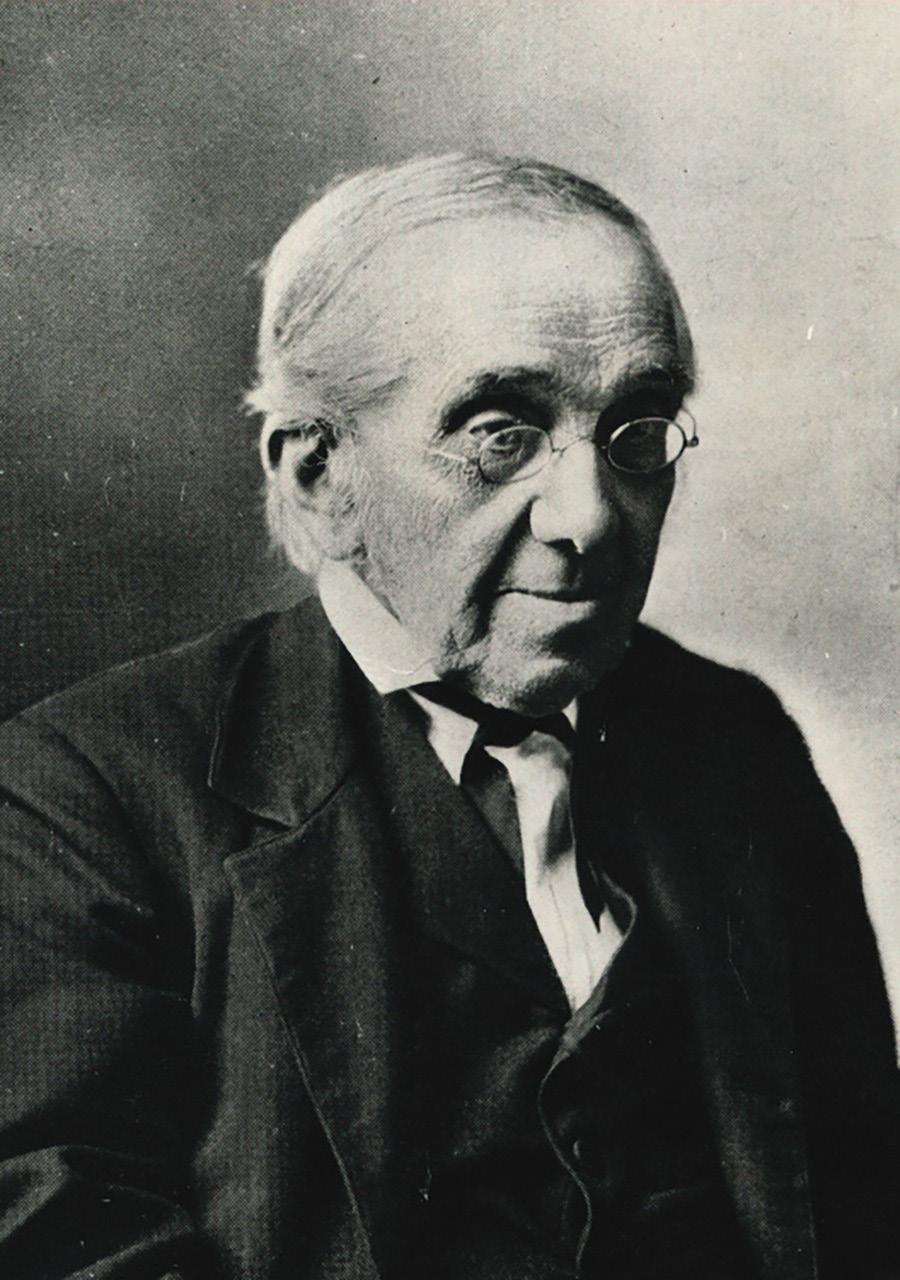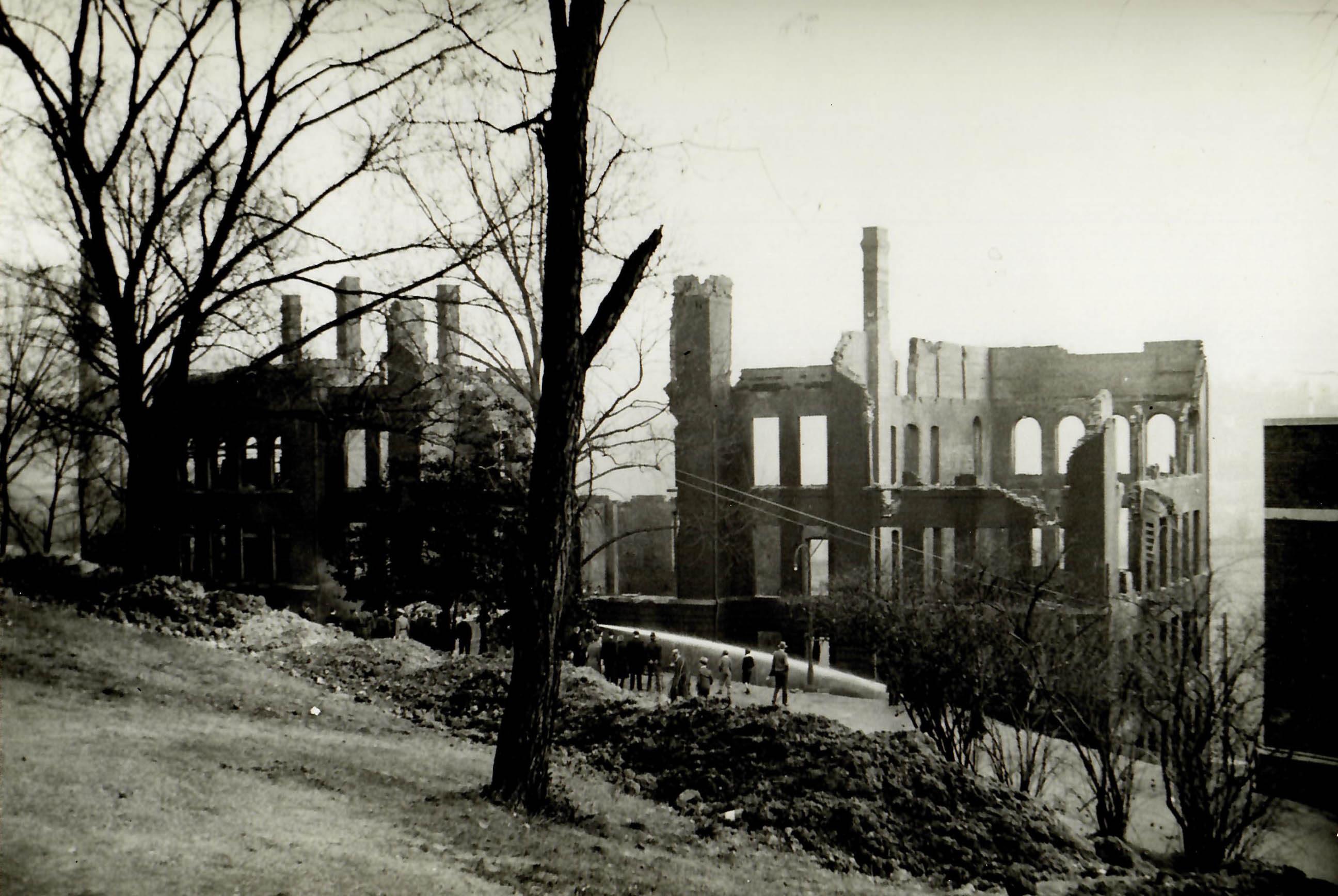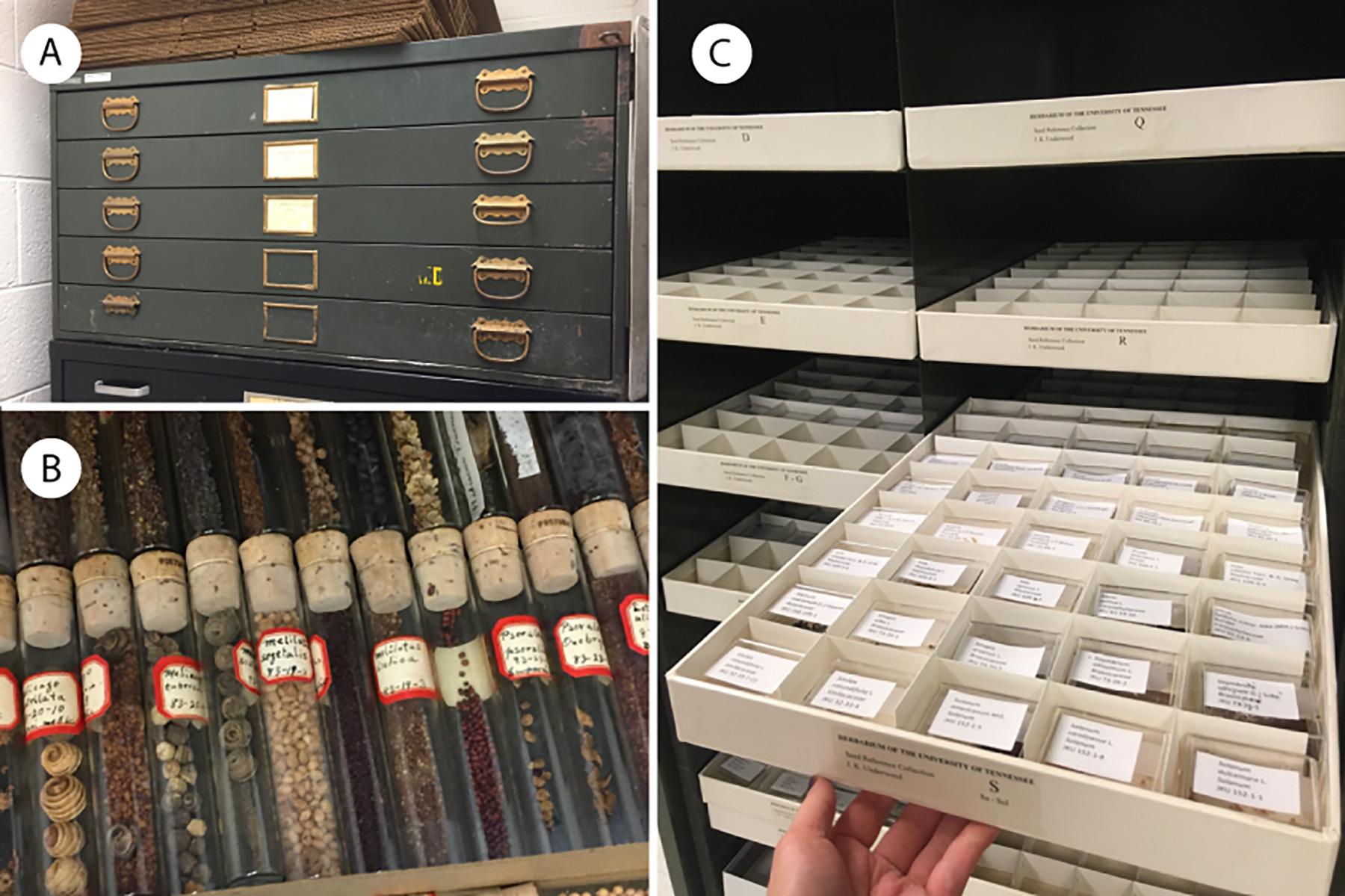
11 minute read
Featured Herbarium: University of Tennessee, Knoxville
Margaret G. Oliver and Jessica Budke
History
Advertisement
The The University of Tennessee, Knoxville Herbarium (TENN) was established in 1888 when the University hired Frank Lamson-Scribner to lead its new Division of Botany and Horticulture and the Agricultural Experiment Station (Tennessee Flora Committee 2015). He had the foresight and vision to convince German-born medical doctor-turned botanist Augustin Gattinger (Fig. 1) to sell his personal collection of over 4,000 specimens to the University of Tennessee, Knoxville (UTK) for $600 in 1889, which is close to $17,000 today. Gattinger’s collections are particularly important since he wrote the first formal flora of Tennessee using these specimens, The Tennessee Flora with Special Reference to the Flora of Nashville (Gattinger 1887).

Fig. 1. “It has been my misfortune to spend thirty years of my life with these half-civilized Tennesseans, and up to now I have not seen a single living Tennessee botanist.” Augustin Gattinger, photo taken in 1901.
Photo courtesy of the Tennessee Historical Society
A major tragedy befell the University when the entire herbarium, including Gattinger’s specimens and years’ worth of research, was lost in January 1934 after a fire broke out in Morrill Hall, the campus building that housed both the TENN Herbarium and Botany Department (Fig. 2). In the following years, the collection was systematically rebuilt by teams of botanists led by A.J. Sharp (Fig. 3), who traversed the state collecting specimens in a repurposed World War II truck, as well as by the generosity of other herbaria that donated their duplicate Tennessee specimens to rebuild the collection (Tennessee Flora Committee 2015).

Fig. 2. Morrill Hall after the fire, January 1934.
Photo courtesy of the TENN herbarium

Fig. 3. Botany field crew at ‘sunset rocks’ on (according to the back inscription) Mount LeConte in the Appalachian Mountains, taken in the 1930’s. From left to right -- front row: L.R. Hesler, Mary B. Wilson, Stanley A. Cain (holding dog, Teddy); middle row: Alice Caton, T. Just; back row: unnamed crew member, Mildred Cain, A.J. Sharp.
Photo of botany crew from the Aaron J. Sharp Collection MS.3780, University of Tennessee, Knoxville, Special Collections
The TENN Herbarium has had several different physical locations on campus over the years. Immediately after the fire in Morrill Hall, the herbarium was moved to the Hesler Biology Building, named for the mycologist and Dean of UTK’s College of Liberal Arts from 1934 to 1958, L.R. Hesler (Petersen 1978). It was then housed in UTK’s Hoskins Library from 1997 until 2013 when it was moved to its current home on the main floor of Temple Hall (Fig. 4). Although this is a ten minute walk from the rest of the biology departments, TENN is now located in the heart of campus and has over 6,000 ft2 of research space composed of ca. 4,000 ft2 of climate controlled collection space and ca. 2,000 ft2 of office and workspace for staff, students, and visiting researchers. The herbarium and other members of UTK’s Botany Department joined the Department of Ecology and Evolutionary Biology (EEB) in 2005.

Fig. 4. (A) Present location of the TENN Herbarium in Temple Hall. (B) Fire resistant herbarium cabinets in the (C) climate controlled collection space.
Photo courtesy of the University of Tennessee, Knoxville.
Digitization, collections, and curation
We are a member of several online Symbiota portals (Gries et al. 2014), enabling us to share our data with a wide audience online: SouthEast Regional Network of Expertise and Collections for vascular plants (SERNEC; https:// sernecportal.org), Consortium of North American Bryophyte Herbaria (https://bryophyteportal.org), Mycology Collections Portal (https://mycoportal.org), Consortium of North American Lichen Herbaria (https://lichenportal. org), and the Macroalgal Herbarium Portal (https://macroalgae.org). A National Science Foundation grant (NSF DBI-0748955) awarded in 2008 helped fully digitize our fungal and lichen collections, which includes images of the specimen labels, georeferenced localities, and transcribed collection data. The University of Tennessee, Chattanooga Herbarium (UCHT) led a large, collaborative digitization project (NSF DBI-1410087) from 2014 to 2019 that included digitizing TENN’s North American vascular specimens. Images of these show the whole specimen and label and the records were deposited with skeletal data, which includes the identification and broad locality (country, state/region, county). TENN students and staff are in the process of georeferencing and transcribing the label data for these specimens using the specimen images deposited in SERNEC. These digitization grants, which are supported by government and thus taxpayer funds, have enabled the data from our collections to reach more researchers and further contribute to studies examining taxonomy, biodiversity, conservation, climate changes, and many others. Our bryophyte collection has had all of the North American specimens digitized with images of the specimen packets and skeletal data and is in the process of being fully transcribed.
Through the efforts of numerous botanists, the TENN Herbarium has grown to be the largest herbarium in Tennessee and the third largest in the southeastern United States with approximately 649,000 specimens (Fig. 4). The majority of our collections have been collected in eastern Tennessee and the southern Appalachian Mountains with additional specimens from other parts of the world, depending on the excursions and interests of various researchers who have worked at UTK over the years. Our vascular collection holds ca. 381,000 specimens and is the largest collection of specimens from Tennessee in the world. It also contains a large number of historical collections from the Great Smoky Mountains National Park, the most biodiverse park in the United States (U.S. National Park Service 2020), and we are working with the National Park Service to designate TENN as an official repository for plant and fungal specimens collected from the park.
Our bryophyte collection houses ca. 183,000 specimens from across the world with particular emphasis on the Pacific Northwest and Alaska in the United States, Mexico, and parts of Asia. In 2017, the TENN Herbarium Director and Bryophyte Curator Jessica Budke worked alongside students to update and reorganize the moss collection from an alphabetical by genus system to alphabetical by family (Goffinet et al. 2009) and created useful reference guides, making it easier for researchers to navigate the collection and use it to learn to identify mosses.
Our fungal collection, primarily composed of Basidiomycotina, contains ca. 74,000 specimens and includes a large collection of clavaroid fungi from China, New Zealand fungi, and numerous type specimens collected during the studies of L.R. Hesler and R.H. Petersen. The lichen collection (ca. 8,000 specimens) includes large collections of specimens from Alaska and Michigan in the United States and parts of Canada.

Fig. 5. The J.K. Underwood Seed Collection. A) Old map cabinet used for storage and B) the original glass vials containing the seeds with cork stoppers and non-archival labels. C) Updated storage in a sealed herbarium cabinet using archival containers and labels. Photos A and B were modified from Miller et al. (2019).
We offer a spring Graduate Research Assistantship (GRA) every year funded by the L.R. Hesler Fund which allows EEB graduate students to gain skills working in the herbarium. Our two most recently curated collections, the J.K. Underwood Seed Collection and a macroalgae teaching collection, were both projects undertaken by GRAs working with undergraduate students and volunteers. These collections had moved around with the herbarium, but had gone uncatalogued—the seed collection was rolling around in glass vials with cork stoppers and non-archival labels in an old map cabinet until 2017 (Fig. 5) and the macroalgae collection had been stored in a cabinet that needed to be taped shut after the handle broke during the move from Hoskins Library to Temple Hall. GRAs worked with undergraduates and volunteers to modernize the curation of these collections—the J.K. Underwood Seed Collection was updated taxonomically, rehoused, and relabeled using archival materials, and the specimens were imaged, which are now available on the TENN Herbarium website (Fig. 5; Miller et al. 2019). After fixing the herbarium cabinet, the macroalgae collection was also reorganized, updated taxonomically, and deposited in the Macroalgal Herbarium Portal. During the curation we discovered specimens from a survey conducted in 1874 by the U.S. Fish Commission in the northeastern United States and a specimen collected by Sylvia Earle in 1964, who, in 1990, became the first woman appointed Chief Scientist of the National Oceanic and Atmospheric Administration (NOAA; Holloway 1992).
Outreach and opportunities
Our herbarium team has grown over the past several years as we emphasize and advertise opportunities for students and volunteers working in our collection. We have four paid undergraduate curatorial technician positions supported by the L.R. Hesler Fund, and because we always have more interested students than we are able to hire, in 2019 we also began to offer semester-long herbarium internships to students for credit. As undergraduates in the paid positions graduate and openings become available we are able to recruit directly from interns who have found a calling working in the herbarium. We’ve also been lucky enough to have several engaged and enthusiastic volunteers consisting of amateur botanists and emeritus UTK staff and faculty. Two of our volunteers who have been donating their time for over three years have together barcoded and imaged over 18,000 liverwort specimens and transcribed thousands of additional bryophyte specimens.
We take advantage of social media as an additional way to connect with our wider campus community and members of the public online. We have social media accounts on Twitter, Instagram, and Facebook—and as a shameless plug, you can follow us @utkherbarium. The herbarium students rock at Internet memes, and by sharing the load among the staff and students at the herbarium we are able to post content most work days during the fall and spring semesters. We encourage the students to develop their own weekly botanical/fungal series or theme that interests them to post about. Over the past couple of years students have developed #MushroomsAndArtHistory, #HerbalMedicineWednesday, and the botany found in the Nintendo game series Animal Crossing. The TENN Collections Manager, Margaret Oliver, also posts #FamilyoftheWeek threads highlighting different plant families in Tennessee, the species in each family you can find in the state, and key characteristics to help everyone learn to identify them.
Our most popular outreach campaign using social media is #HerbMadness, which we put on in the spring to coincide with the National Collegiate Athletic Association Division I college basketball tournaments. Prior to the start of our botanical tournament we take nominations for plant, fungi, and algae genera that people want to see compete and create fact sheets for each of them. The public then gets to vote for their favorites as they go head-tohead in a weekly bracket/competition that starts with 32 genera and ends with a single champion. The first ever champion in 2018 was Quercus L., and the fern genus Azolla Lam. was 2019’s champion, nominated by the Massey Herbarium (VPI). The 2020 competition saw the beautiful flowering genus Rhododendron L. come out on top, though Sphagnum L. gave it a run for its money.

Fig. 6. Undergraduate herbarium curatorial technician Becca Atkins (class of 2019) showing enthusiasm for plant puns on the chalkboard sandwich sign outside of the herbarium in March 2018.
Not only are we interested in engaging with people online, but we think it is critical for members of our campus community to visit the herbarium in person. Temple Hall is about a ten-minute walk from the rest of the EEB Department on campus so many colleagues had not visited since our 2013 move. Thus, in 2018 we began an open house event, Specimens and Scones, that we host twice a semester. These events are an opportunity for students, faculty, and anyone from the broader campus community to visit the herbarium for a behind-the-scenes tour of our collections and learn about the research we facilitate while also enjoying a tasty, locally baked treat and a hot beverage in hand-thrown mugs made by our herbarium Director. Fortunately, we are located on the ground floor of the building and our main lobby faces the street that will soon be an extended pedestrian walkway. We use a colorful and ever-changing chalkboard sandwich sign (Fig.6) in front of the entrance to the herbarium to encourage people to walk in off the street and visit the herbarium. Last year we recorded 85 student visitors who had never seen an herbarium before and were drawn in by the sign! Although the pandemic has put a temporary hold on these gatherings and walk-in visitors we look forward to hosting them again when it’s safe for in-person gatherings.
The TENN Herbarium is grateful to have a strong history of financial support, enabling us to offer multiple funding opportunities to visiting researchers, students, and faculty. The Breedlove, Dennis Fund Awards for Student Botanical Field Experiences was generously started by Breedlove, Dennis & Associates, Inc. (www.bda-inc.com) and Mike Dennis, an alumnus of the UTK Botany Department. It offers financial support for undergraduate and graduate students to pursue botanically-based fieldwork and accepts applications on a rolling basis (Fig.7). You can learn about previous student projects which have been supported by the Breedlove, Dennis Fund on our website (https://herbarium.utk.edu/Previous%20Breedlove%20Dennis%20Awards.pdf). The L.R. Hesler Fund supports awards to undergraduate and graduate students, EEB faculty, and visiting researchers for herbarium-based research. The Hesler Fund visiting researchers awards are open to graduate students, postdocs, faculty, and independent researchers from anywhere in the world who want to collaborate with an EEB faculty or staff member on a research project using specimens from the TENN Herbarium. Application details are available online (https:// herbarium.utk.edu/HeslerVisitingResearcherAward.pdf) and we typically accept applications from the end of November to January.

Fig. 7. Field work supported by the Breedlove, Dennis Fund. (A) Undergraduates Jackson Turner (left) and Rosy Harpe (right, class of 2019) in the Great Smoky Mountains National Park; (B) graduate student Alex Aromin collecting moss specimens in New York, United States; (C) graduate student Jacob Moutouama (far right) with his EEB faculty advisor Arou Gaoue (center) and a field assistant in Benin; and (D) an herbarium excursion to the Hiwassee River, Tennessee, United States with undergraduate students Joanna Huntoon (far right) and Helen Law (the photographer, class of 2019) with volunteer Lynne Davis (center right), Herbarium Director Jessica Budke (center left), and Collections Manager Margaret Oliver (far left).
We will also begin offering a new funding opportunity for students in fall 2020—the Lynne and Bob Davis Herbarium Award was generously started by our two longest herbarium volunteers and will help fund undergraduate research projects focusing on plant taxonomy, natural history, and floristics. We are very excited to be offering this new award in addition to the Breedlove, Dennis and Hesler awards. Anyone who is interested in learning more about these funding opportunities can access all of the requirements and applications through the TENN Herbarium website (https://herbarium.utk.edu/) or by contacting our Collections Manager (molive18@utk.edu).
The expansion of TENN’s outreach, student opportunities, and engagement with the community has made us more visible on campus. We regularly interact with students and administrators who have never heard of a herbarium, have no idea what we do (or think we’re a botanic garden), or don’t know that we exist on the UTK campus. In a world where defunding natural history collections or eliminating them completely has been viewed as a viable solution during financial crises of the past (Dalton 2003, Gropp 2003), it’s more important than ever for us to continue advocating for the value of collections as a record of the past and a resource for the future.
Acknowledgements
Thank you to the National Science Foundation for its continued support of natural history collections. Thank you to Alex Aromin, Bob and Lynne Davis, Rosy Harpe, Jacob Moutouama, and Jackson Turner as well as the Tennessee Historical Society and the University of Tennessee, Knoxville–Special Collections for granting us permission to use photos.
Margaret G. Oliver, Collections Manager, University of Tennessee, Knoxville
Jessica M. Budke, Herbarium Director, University of Tennessee, Knoxville; Email for correspondence: jbudke@utk.edu










